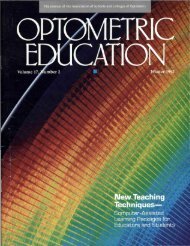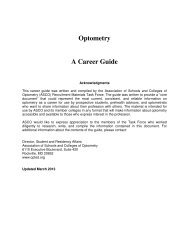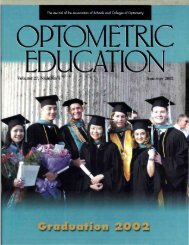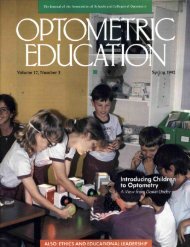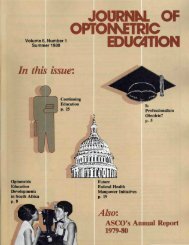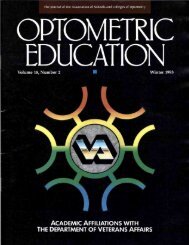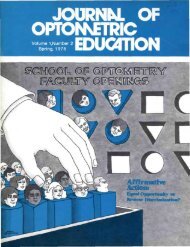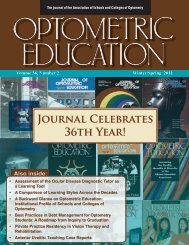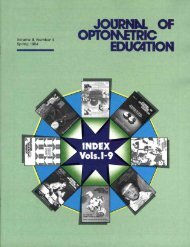Summer 2012, Volume 37, Number 3 - Association of Schools and ...
Summer 2012, Volume 37, Number 3 - Association of Schools and ...
Summer 2012, Volume 37, Number 3 - Association of Schools and ...
Create successful ePaper yourself
Turn your PDF publications into a flip-book with our unique Google optimized e-Paper software.
<strong>and</strong> 1993, <strong>and</strong> multiple-year periods,<br />
(1988-1991) <strong>and</strong> (1997-1998).<br />
Total Enrollment numbers were<br />
calculated from information provided<br />
whenever possible. Beginning with<br />
1975, the counts <strong>and</strong> percentage<br />
<strong>of</strong> the student body attributed to<br />
minorities (Black, Hispanic, Asian <strong>and</strong><br />
Other) were available, but a count for<br />
Total Enrollment did not appear in<br />
the reports. Thus, Total Enrollment<br />
numbers for 1975-1980, 1982-1986,<br />
<strong>and</strong> 1992-1996 were calculated by<br />
dividing the percent <strong>of</strong> minority<br />
students into the sum <strong>of</strong> minority<br />
students. All decimals at 0.5 <strong>and</strong> above<br />
were rounded to the next larger integer.<br />
When reports were missing for single<br />
years, the midpoint between the<br />
two adjacent years was chosen as an<br />
estimate for Total Enrollment <strong>and</strong><br />
for each <strong>of</strong> the race <strong>and</strong> ethnicity<br />
categories. For the three periods with<br />
missing multiple-year annual reports, a<br />
linear regression using the least squares<br />
method was fitted to the four adjacent<br />
values for the period, i.e., two years<br />
before <strong>and</strong> two years after the period<br />
<strong>of</strong> missing data. The equations for each<br />
<strong>of</strong> these lines were used to estimate<br />
counts for Total Enrollment as well as<br />
each category <strong>of</strong> race <strong>and</strong> ethnicity in<br />
the missing periods.<br />
Estimating graduates by race <strong>and</strong><br />
ethnicity<br />
The doctor <strong>of</strong> optometry program is<br />
a four-year curriculum, <strong>and</strong> typically<br />
students enroll after completing a<br />
baccalaureate degree. Annual numbers<br />
<strong>of</strong> graduates in each racial <strong>and</strong> ethnic<br />
group were estimated by taking<br />
one quarter <strong>of</strong> Total Enrollment for<br />
each year. This method assumes that<br />
attrition is already accounted for in<br />
the Total Enrollment numbers <strong>of</strong> each<br />
academic year. A systematic review<br />
<strong>of</strong> literature in medicine showed that<br />
race <strong>and</strong> ethnicity were not associated<br />
with attrition from medical school. 26<br />
If minority student attrition rates<br />
were higher in optometry, then the<br />
estimates for minority optometrists<br />
in this paper will be larger than actual<br />
proportions.<br />
Method to estimate numbers <strong>of</strong><br />
optometrists in 2011<br />
The number <strong>of</strong> clinician optometrists<br />
in 2011 was estimated by using two<br />
key assumptions. First, 10% <strong>of</strong> the<br />
graduates are assumed to pursue<br />
a non-clinical career. 13 Second,<br />
retirement is assumed to begin 30<br />
years after graduation. The youngest<br />
age at graduation is assumed to be 25,<br />
thus retirement will begin for 10% <strong>of</strong><br />
each year’s graduates at the age <strong>of</strong> 55.<br />
The rate <strong>of</strong> retirement is set at a<br />
constant rate <strong>of</strong> 10% per year in the<br />
period 30 to 40 years after graduation,<br />
from age 55 to 65. At 40 years after<br />
graduation, all are assumed to have<br />
ceased clinical practice full-time. The<br />
general economic climate, 27 the supply<br />
<strong>of</strong> clinicians relative to dem<strong>and</strong> for<br />
services, <strong>and</strong> federal law raising the<br />
minimum m<strong>and</strong>atory retirement age 28<br />
are macro-level factors that contribute<br />
to varying rates <strong>of</strong> retirement over<br />
the years. The average retirement age<br />
in the United States was 67 in 1950,<br />
but has dropped to 62 in 2000. 29<br />
The economic downturn in more<br />
recent years suggests that retirement<br />
age is delayed for certain cohorts<br />
<strong>of</strong> clinicians. 30-32 For the purposes<br />
<strong>of</strong> building a model <strong>and</strong> making<br />
an estimate encompassing almost a<br />
half-century <strong>of</strong> data, the retirement<br />
rate was assumed to be a straight-line<br />
function. Attrition from the pr<strong>of</strong>ession<br />
is assumed to be constant across racial<br />
<strong>and</strong> ethnic groups.<br />
For reference, the estimates in the<br />
model were compared (Figure 1)<br />
with available data published by the<br />
U.S. Department <strong>of</strong> Labor, U.S.<br />
Department <strong>of</strong> Health <strong>and</strong> Human<br />
Services, <strong>and</strong> the AOA. 14,16,33 The<br />
gap between the model <strong>and</strong> federal<br />
estimates is due to constructing a<br />
model that begins with enrollment<br />
in 1969, <strong>and</strong> assumes that there were<br />
no optometrists before that date.<br />
This was necessary because there<br />
was no information about the age <strong>of</strong><br />
optometrists in the numbers from<br />
the federal estimates, thus making it<br />
impossible to factor in retirement.<br />
Comparing race <strong>and</strong> ethnicity<br />
proportions with population<br />
The final estimates for the race<br />
<strong>and</strong> ethnicity <strong>of</strong> optometrists were<br />
compared with U.S. Census 2010.<br />
The assumption in this paper is that<br />
primary eye care will serve all age<br />
groups <strong>and</strong> all races, so no adjustments<br />
were made to account for any<br />
variability in the need for eye care<br />
due to race or age <strong>of</strong> the population<br />
segments.<br />
Figure 1<br />
Comparing Estimates <strong>of</strong> U.S. Optometrists<br />
Optometric Education 109 <strong>Volume</strong> <strong>37</strong>, <strong>Number</strong> 3 / <strong>Summer</strong> <strong>2012</strong>



